Intraday Market Thoughts Archives
Displaying results for week of Mar 20, 2016Dollar Gains Dulled, Japan CPI Due
A weak durable goods report and position squaring ahead of the long weekend hurt the US dollar Thursday. The pound was the top performer and the yen lagged. Japanese CPI is due later and Australia is on holiday. In the Premium Insights, GBPUSD was closed at a 215-pip gain, while leaving one other GBP pair in progress alongside 3 other trades.
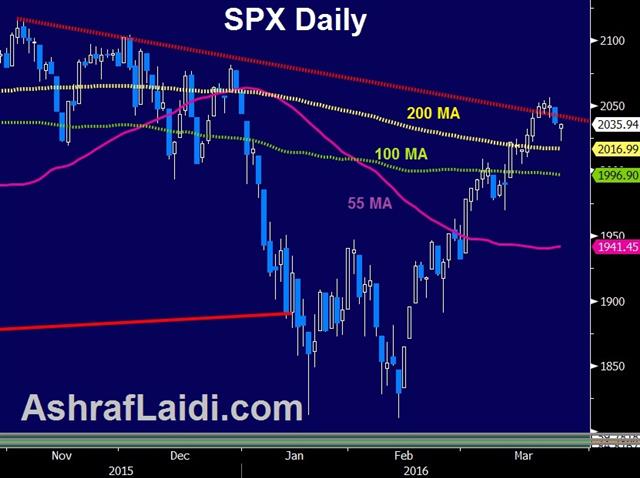
The US dollar peaked early in New York trading but sagged after a disappointing durable goods orders report. EUR/USD touched a session (and weekly) low of 1.1142 prior to the release and slowly climbed to 1.1172 as the day wore on. Core durable goods orders fell 1.8% compared to a 0.5% decline expected. The prior was also revised to 3.1% from 3.4%. The numbers didn't cause an immediate reaction in the dollar but with the long weekend looming, a small retracement of this week's dollar strength wasn't a surprise.
Other US economic data included a small improvement in weekly initial jobless claims to 265K compared to 269K expected. Weekly Baker Hughes data showed a sharp drop in oil drilling rigs to 372 from 387. That helped lift oil from $38.34 to $39.61.
In the past two weeks the market has been rattled by a number of events including the euro reversal after the ECB and the Fed surprise. Speculative positions have fallen towards flat and many research notes we're reading lack any kind of conviction.
In time the market will find a fresh theme. Significant economic data hits in the next two weeks and that will result in more sustained market moves. One spot we're watching especially closely is the commodity bloc. There have been signs this week that the resource rebound is waning. That could be a false signal because it was a quiet week. Yellen speaks next Tuesday at the Economic Club of NY.
Japan will remain in focus with USD/JPY within striking distance of 15 month lows. The BOJ is desperate for some sign of inflation. The Feb CPI report is due at 2330 GMT and is expected to show prices up just 0.3% y/y and flat ex-food and energy. Tokyo CPI for March is forecast to decline 0.2% y/y.
| Act | Exp | Prev | GMT |
|---|---|---|---|
| Core Durable Goods Orders (m/m) | |||
| -1.0% | -0.2% | 1.7% | Mar 24 12:30 |
| Continuing Jobless Claims (MAR 11) | |||
| 2.179M | 2.230M | 2.218M | Mar 24 12:30 |
| Initial Jobless Claims (MAR 18) | |||
| 265K | 268K | 259K | Mar 24 12:30 |
Commodity Bounce Fades, USD March Continues
The power of oversupply was in focus once again as US weekly inventory data showed nearly 10 million barrels of crude going into inventories. Oil fell 4% and the Canadian dollar lagged as the broad US dollar bid continued on more hawkish Fed talk. The Asia-Pacific calendar is light after New Zealand trade balance beat expectations.
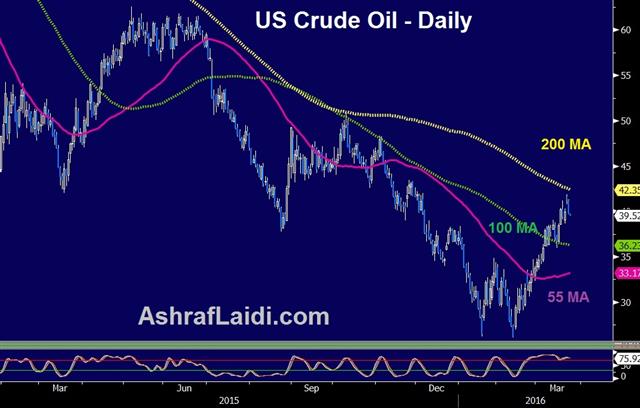
Was $26 an oil bottom or just a bounce? WTI crude hit $42 late last week in a nearly 50% rally from the bottom but it stumbled Tuesday. The rebound higher is typical of a bear-market rally. Back in August crude soared to $49 from $39 in just three sessions in what later proved to be a fleeting move.
The tailwind for crude has been jawboning about a production freeze from major producers inside and outside OPEC. Ultimately, it will be a token gesture. Russian oil companies have already been revealed to have previously planned to cut or freeze production and many OPEC members are at maximum output.
The overriding factor is supply. EIA inventories rose 9.4 million barrels last week compared to 2.5m expected. Inventories are at all-time highs and nearing capacity with the Spring maintenance season approaching.
CAD traders punished the currency. News of a stimulative budget yesterday led to some mild upgrades of GDP forecasts and the BoC will do the same but the good news is now baked into the currency and the risks are that the supply-driven commodity crunch resumes.
What may cushion a fall and prevent a return to 1.44 in USD/CAD is that global demand remains decent. US new home sales were slightly stronger than expected Tuesday and more Fed members were upbeat on the economy. Bullard said there may be a case for an April hike. Realistically, April isn't a date for a Fed hike but if economic data improves – beginning with Wednesday's durable goods report – then June will be back on the table.
Early in Asia-Pacific trading, the New Zealand dollar got a small lift from strong Feb trade numbers. Exports at 4.25B were much stronger than $4.01B expected and imports matched expectations in a sign of solid domestic demand. That pushed the trade surplus to $339m from $90m exp.
The remainder of the Asia-Pacific calendar is light. We remind readers that Friday is a holiday in the US, Europe and Antipodeans so that's likely to curb volatility in the day ahead.
| Act | Exp | Prev | GMT |
|---|---|---|---|
| Trade Balance | |||
| 339M | 75M | 13M | Mar 23 21:45 |
| New Home Sales (FEB) (m/m) | |||
| 0.512M | 0.510M | 0.502M | Mar 23 14:00 |
| New Home Sales Change (FEB) (m/m) | |||
| 2.0% | 3.2% | -7.0% | Mar 23 14:00 |
| Durable Goods Orders (FEB) | |||
| -2.9% | 4.7% | Mar 24 12:30 | |
| Durable Goods Orders ex Transportation (FEB) | |||
| -0.2% | 1.7% | Mar 24 12:30 | |
Dollar Grind Finds a Way
Hawkish comments from an unexpected place helped to boost the US dollar on Tuesday. The Australian dollar was the leader on the day while the pound struggled on Brexit worries. Australian skilled vacancies, BOJ comments and US politics are in focus later. A new trade was issued in early London morning, bringing the number of existing trades to five, one in equity, three in FX and one in commodity.
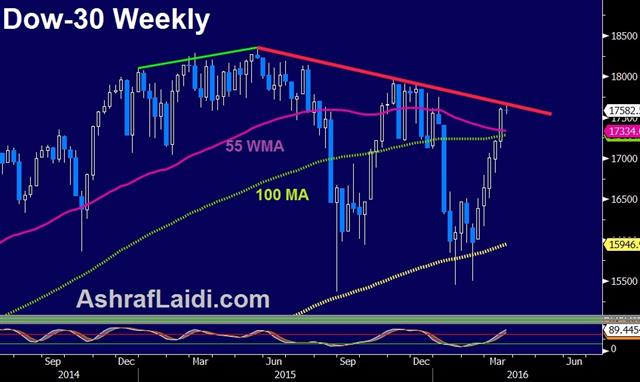
Excluding the hour after the FOMC decision, the US dollar has now outperformed the euro and pound sterling. Its losses against the yen, CAD and Swiss franc are minor.
Often times, a shock decision like the FOMC leads to continued momentum. When that momentum stalls so quickly and reverses, it's a powerful signal.
On Monday, the Fed's Williams and Lockhart pushed back with some hawkish commentary. Tuesday it was from a far more unlikely source; Chicago Fed President Charles Evans. He's is regarded as the most dovish Fed member and he said he was comfortable with two hikes this year while sounding an upbeat tone on the economy.
The US dollar climbed nearly a full cent in New York trading against the yen, touching just above 112.50. That was largely due to reduced risk aversion after the tragic Brussels attack but the broader theme of a post-Fed US dollar recovery is intact.
In order to sustain it, the data must cooperate. There was some evidence in the Richmond Fed as it rose to the highest since 2010 at +22 compared to 0 expected. That was balanced by the Markit PMI at 51.4 versus 51.9 expected.
Another standout Tuesday was the Australian dollar. RBA Gov Stevens launched a defiant round of jawboning despite US warnings but it was not enough. The Aussie sank to a three day low of 0.7550 but reversed almost a cent to 0.7642.
It will remain in focus with the Feb skilled vacancies report at 0000 GMT. The prior reading was +0.4%. Another event to watch is the BOJ's Funo speaking at 0130 GMT.
Finally, Arizona holds its primary and that's expected to help Donald Trump tighten his grip on the Republican nomination. That's something Jeffrey Gundlach warned will cause market turbulence later this year and something we will explore in the future.
What to Make of the Dollar Creep
The US dollar was the top performer on Monday and has been the best performer since the end of day on FOMC day. Is it a signal that Fed concerns are overrated or simply a technical bounce? Australian house prices, RBA comments and Japanese manufacturing data are due later. A new Premium Video will be posted and sent to members at the start of the Tuesday Tokyo, revisiting the 2008Parallel and tackling the technical dynamics of the AAII Investor Sentiment vs the S&P500.
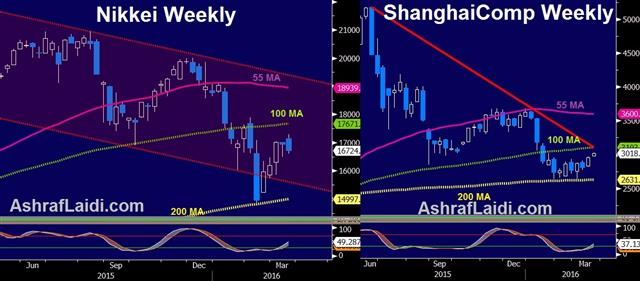
USD edged higher across the board to start the week in light trading. USD/JPY rose for the second day in a slow rally to 112.16 from 111.50.
At this point, most of those who missed the initial dollar drop on the Fed headlines and chased dollar shorts underwater. The dollar continued to fall the day after the Fed but has now nearly recovered.
The problem for dollar bears is that the Fed remains relatively hawkish. The ECB and BoJ are delivering more stimulus, Brexit concerns are hitting the UK and commodity currency central banks have an easing bias. In addition, Treasurys offer better yield and the US stock market is up 10% since mid-February.
On Monday, Fed Presidents Lockhart and Williams both delivered speeches where they said rates could rise as soon as April. The market largely dismissed them but they reemphasized that the Fed isn't worried about the domestic economy; they see the risks abroad.
The 1.1200/20 range is an important zone to watch in EUR/USD in the days ahead. The pair is trading at 1.1243 and a fall below that zone would break into the Fed move. The lesson in all this is that the US dollar might not need the Fed's help to sustain gains.
Then again, it's early and the dollar retracement has come in a quiet environment. With Japan returning from holiday on Tuesday, we expect a more lively market.
Asia-Pacific newsflow may help. At 0030 GMT the Australian Q4 home price report is due and expected to show housing prices up 8.5% y/y but flat in the quarter. It may not be long before Stevens gets to respond to the latest developments as he speaks at 0515 GMT and the RBA's Edey is also on a panel at 0045 GMT.
At 0200 GMT, the Nikkei Japan PMI for manufacturing is due. It's expected to rise to 50.5 from 50.1. It will be followed at 0430 GMT by the all industry activity index for Feb, which is forecast to rise 1.9%.
The BOJ's Nakaso spoke Monday and said officials want time to evaluate the latest moves. That's telling; it means that Kuroda can attempt to jawbone but it will be months before there is any real threat of action. The 110.67 to 112.00 range is key for now.
| Act | Exp | Prev | GMT |
|---|---|---|---|
| HPI (JAN) (m/m) | |||
| 0.5% | 0.4% | Mar 22 13:00 | |
| Fed's Evans Speech | |||
| Mar 22 17:30 | |||
| RBA Assist Gov Edey Speech | |||
| Mar 22 0:45 | |||
| RBA's Governor Glenn Stevens Speech | |||
| Mar 22 5:30 | |||
| Markit Manufacturing PMI (MAR) [P] | |||
| 51.3 | Mar 22 13:45 | ||
| Nikkei PMI Manufacturing (MAR) [P] | |||
| 50.1 | Mar 22 2:00 | ||
| All Industry Activity Index (JAN) (m/m) | |||
| 1.9% | -0.9% | Mar 22 4:30 | |
China’s Debt Problem
China is in focus early this week after the central bank leader warned about rising debt levels. The yen was the top performer last week while the US dollar lagged. Weekly CFTC positioning data showed a squeeze in CAD and GBP shorts. There are currently 4 Premium trades in progress after EURUSD was closed at a profit and GBPUSD was stopped out. It will be a holiday shortened week. but not short of Fed speech.
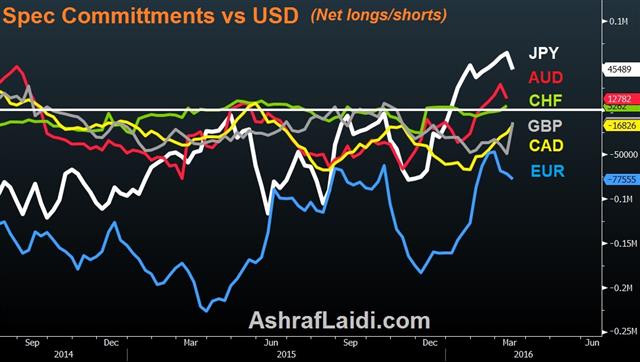
Weekend news was generally light but the PBOC's Zhou shed some rare light on growing problem. He said regulators want to tackle debt and warned that corporate lending as a share of GDP is too high. This may not matter to many after the Shanghai Composite regained 3000. Other new data such as the average Chinese account receivable takes over 80 days to be settled is also being taken into notice.
China bears often point to the overburdened lending market as a particular vulnerability. In the past two years, there were efforts to tighten up lending and quiet some of the risks. But in the past month, much of it has unwound. China has reopened the property-lending taps and has unveiled a program to buy bad bank debts.
It came after Chinese growth hit a minor bump. On the weekend, MNI reports that the NDRC Chairman said growth will be above 6.5% in each of the next five years.
So what other options does China have? Zhou hinted they will try to entice savers to invest in capital markets. By developing and liberalizing them, companies could use equity or non-bank lending more effectively. In order to make that transition the government will want to curb volatility in Chinese stock markets. Look for more intervention and steady gains in Shanghai shares in the coming months.
Commitments of Traders
Speculative net futures trader positions as of the close on Tuesday. Net short denoted by - long by +.EUR -78K vs -72K prior JPY +46K vs +64K prior GBP -14K vs -49K prior CHF +5K vs -0.1K prior AUD +13K vs +29K prior CAD -17K vs -26K prior NZD +K vs -2K prior
Significant swings in sentiment last week highlight a market that's suddenly off balance. The market was buying back CAD shorts but fell out of love with AUD. Cable shorts rushed for the exits and yen longs hesitated. The FOMC on Wednesday will have speculators even more rattled.
| Act | Exp | Prev | GMT |
|---|---|---|---|
| Fed's Lockhart speech | |||
| Mar 21 16:40 | |||
| RBA Assist Gov Edey Speech | |||
| Mar 22 0:45 | |||
| RBA's Governor Glenn Stevens Speech | |||
| Mar 22 5:30 | |||







